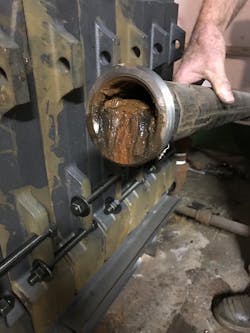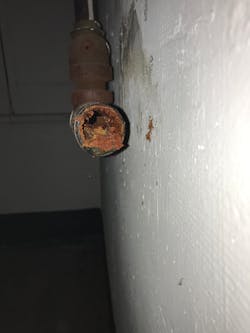Latest from Hydronics
Sponsored
I had been to this house before, up the long driveway off the private drive in one of Cincinnati’s real old money neighborhoods, where the houses stay in the family. The next member of the family to own this house was interested in changing the original equipment two pipe steam system to high efficiency hot water. I love steam, but I understand why people want to make the conversion.
The contractor and I were admiring the new copper gutters and downspouts while we chit chatted by the front door. He said those and the new roof came from our roofing division. Installed price was a cool quarter million. The family’s estate took care of that bill. At that point, it didn’t seem that money was going to be problem.
On the return trip to finalize a quote for the new steam boiler, we discussed options for upgrading to a new boiler feed system, since the boiler was well over my threshold for adding a reservoir tank and pump. However, this is a residential application and boiler feed systems can be noisy. I was thinking of a nice quiet gravity return.
It was time to take a closer look at how the old system returned condensate to the boiler. We found that part of the original equipment in this house when it had a coal-fired boiler was a boiler return trap. (See page 100 of my Field Guide for detailed explanation. It is available as a free download at steamupairoutwaterback.com.)
The return trap pushed water back into the boiler if the coal fire got roaring too much and made the steam pressure too high. On gravity return, if the pressure is too high, the water can’t get back into the boiler. It rises up to the horizontal piping to cause lots of problems.
These devices are on a lot of the grand old systems from the 1920’s, but became obsolete when automatic fired boilers came on the scene in the 1930’s. With automatic fire, a pressure high limit control turns off the boiler if the pressure gets too high.
Our attention then went to the wet returns, the pipe below the waterline of the boiler. They were about 30” above the floor. This was fine when the boiler was coal-fired and its waterline was about five feet off the floor. But the boiler to be replaced had a much lower waterline, right about that 30” level. When I saw that, I thought of Jimi Hendrix and the line from his blues song Red House, “Wait a minute something’s wrong here, this key won’t unlock this door.” It wasn’t a door I was worried about, but the height of the wet return.
It didn’t take long to get the call, but it wasn’t about water hammer. The installing contractor, who I have known since I started in the industry, had a question on connecting the header/equalizer to the supply main and wanted me to take a look at what he found when he opened up the piping. Photo 1 shows the sludge that accumulated at the return connection to the boiler. As you can see, that pipe is 75% full of sludge. The restriction slows the flow of water back to the boiler.
To check further, more of the return piping was removed near the boiler. Again, the piping was at least 50% clogged. To further prove the point, we opened up the end of the wet return that is farthest away, which is shown in Photo 2. Armed with the evidence of a clogged wet return and the need to lower it, the contractor was finally able to convince the homeowner to authorize its replacement.
When it came to sizing the new wet return, we decided to use 2”, the largest pipe size the contractor could cut and thread with his favorite pipe machine. The condensate return should now flow freely through the wet return then back into the boiler, quietly with no moving parts. It will also take more time to fill up with sludge.
It is important to remember that the old coal-fired boilers of the 1920’s held a lot more water than the modern gas and oil boilers we use today. With more water in the older boilers, the waterline of the boiler went down slower as it steamed, which kept the automatic feeder from adding water prematurely, which kept the waterline from flooding.
What we’re trying to do on this job is keep the condensate flowing freely back to the boiler, below the waterline of the boiler. This should keep the system from flooding and making strange noises in the middle of the night.
Happy Holidays!
Patrick Linhardt is a thirty-seven-year veteran of the wholesale side of the hydronic industry who has been designing and troubleshooting steam and hot water heating systems, pumps and controls on an almost daily basis. An educator and author, he is currently Hydronic Manager at the Corken Steel Products Co.
Patrick Linhardt
Patrick Linhardt is a forty-one-year veteran of the wholesale side of the hydronic industry who has been designing and troubleshooting steam and hot water heating systems, pumps and controls on an almost daily basis. An educator and author, he is currently Hydronic Manager at the Corken Steel Products Co.




